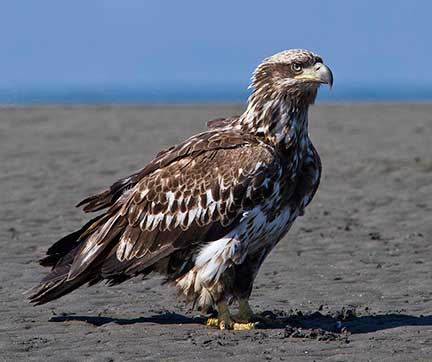 |
Previous Issues |
| Cedar Mill Community Website |
|
Search the Cedar Mill News: |
About The Cedar Mill News |
|
|||||||
| Volume 11, Issue 8 | August 2013 |
||||||
Babies
|
||||
 |
| A two-year-old Bald Eagle. Photo taken in Homer, Alaska, June 2012. © 2013 by Jeff Young. |
In many birding magazines and websites, the nuanced discussion is long and sometimes contradictory about when to call a particular bird species a nestling, a fledgling, a juvenile, an immature or a subadult, or a chick or duckling or some specific term such as cygnet for swans. While we can leave these debates to ornithologists, it is a source of great pleasure as well as learning to observe the variety in our own environments.
Generally when birds hatch they are relatively free of feathers or are covered with very fine “downy” feathers. As they begin to develop, they produce rather “fluffy” juvenile feathers. The young birds grow really quickly to achieve adult size in the space of a few weeks, and can generally fly within a couple weeks of hatching. Therefore, to see “babies,” one looks not for size but for variations in feather patterns, color and also in bird behavior.
Last week I was sitting in my yard with a friend and we noticed two Downy Woodpeckers at the suet feeder. One was sitting on top of the feeder rather loudly verbalizing and flapping its feathers. The other obligingly got some suet and delivered a nice packet to the “chick” on the top of the feeder. Many young birds, even though they are as large as the parent, are able to fly, and certainly are able physically to peck at the suet, still ask to be fed and will beg. A typical begging posture is one where the younger birds call in a high pitched tone and flap their feathers but don’t fly off. I have seen almost all species exhibit this behavior—from the four Black Capped Chickadees who nested in the birdhouse on our deck, to the Red Breasted Nuthatches and the American Robins.
Another clue to youth is that the feathers look “fluffier” and less colorful. Many birds don’t develop their full adult coloration till many molts later. The most obvious to many Americans is the Bald Eagle, which can take three to five years to develop the white head that is emblematic in the adult birds. Bald Eagles who are four years old are typically called subadults, which is the bird term for teenagers.
So notice what is in your yard! Which Robins have spotted breasts indicating youth? Which Chickadees have larger beaks—the beak shape has not solidified to the adult shape yet? Which Woodpeckers have orange on the backs of heads rather than bright red, indicating a newly molted juvenile. These physical characteristics, along with behavior, can be clues to the newly-hatched. Hopefully they enhance your enjoyment of the diversity in our yards.
Lauretta Young MD is the Director of Integrative Medicine for Students at OHSU. She also has a custom bird tour company that takes out birders of all skill levels to learn more about the marvels of birding. See her web site at www.portlandbirdwatching.com and her husband’s photo site at www.flickrphotos.com/youngbirders.
![]()
Like us on Facebook for timely updates
Published monthly by Pioneer Marketing & Design
Publisher/Editor:Virginia Bruce
info@cedarmillnews.com
PO Box 91061
Portland, Oregon 97291
© 2013